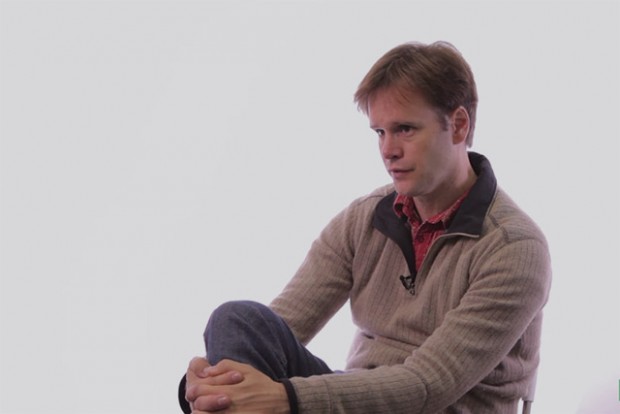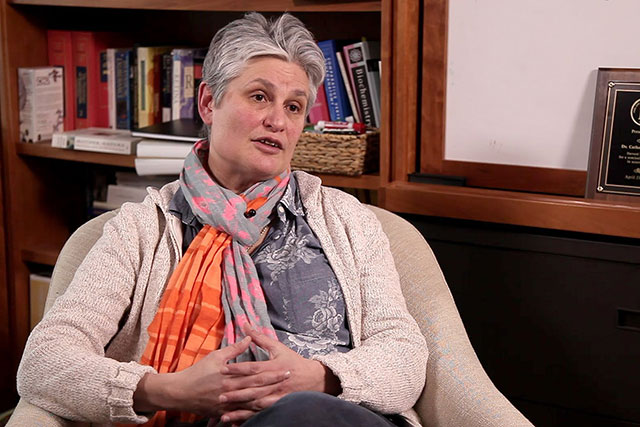Neurophilosophy and Moral Values
Neurophilosopher Patricia Churchland on altruism, the hormone of sociality, and moral dilemmas
videos | September 14, 2015
Where does the willingness to sacrifice oneself for others come from? How did sociality emerge? Why is being born immature beneficial for an animal? These and other questions are answered by UC President’s Professor of Philosophy Emerita at the University of California, San Diego Patricia Churchland.
How do humans care about each other? – A question that has long puzzled philosophers and scientists and just about everybody is where moral values come from. And recently developments in neuroscience, I think, have given us some very important ideas about the basis for that. So we know, of course, that all nervous systems must be organized in such a way as to see to their own survival. They must be organized so that they seek food and water and mates, so that they avoid threats, so that they feel fear at the right time and run away or stay and fight and so forth. But they are all organized to see to their own self interest, to their own care. We understand why this would have happened because in the evolution of organisms, any organism that lacks the circuitry to see to its own needs will not long survive. It will starve to death or it will become dinner for some other organism. And in a very important sense what this means is that the value of self-concern, of taking care of oneself is built into the very circuitry itself. And I think we understand how in a really fundamental way the value of self-survival can actually be embodied in this very very ancient circuitry. And all animals have that. But that, of course, is a little different from the question of how it is that some animals also care for others. And so the question has been how is it that in the context of all of this circuitry for self-survival how can care for others, where that sometimes involves a sacrifice to oneself, where can that possibly come from?

Now we see social behavior in insects, in fish as well as in mammals. But the social behavior that we see in mammals and also in birds has a kind of flexibility and the sophistication and a whole level of complexity that’s really very different. So the question is how did sociality emerge – put morality aside for the moment – what drove, within the biological evolution of the animals, what drove sociality? And one approach to thinking about this is very interesting. At some point about 250 million years ago warm-blooded reptiles appeared. Now, it had a great advantage because it meant they could hunt at night when everybody else was waiting for the sun to come up. It also meant that the warm-blooded animals were able to move and forage in places where the cold-blooded animals couldn’t forage. The downside of being warm-blooded is that gram for gram in weight. A warm-blooded animal has to eat ten times as much to keep the whole thing going. So this put tremendous evolutionary pressure on warm-blooded animals. As a result, over millions of years of evolution something rather extraordinary occurred. Mammals emerged and they had fewer babies, so they might have one or two or three or five babies at a time instead of 100 or 150 as a turtle might do in laying its eggs. But a very special thing changed and that is that the young were born very immature. What’s the good of that? The answer is a tremendous good because the immature brain can tune itself up to the environment. And along with this we see the development of neocortex and that’s unique to mammals and birds. And it’s this highly regular sixth or seven layer structure that overlies the more ancient neural structures. And that seems to be very immature at birth and that is tuned up or organized to a great extent as a function of the animal’s experience in the world.
And mammalian brains or in human brains we see something like a million synapses’ connectivity between neurons, a million synapses made per second in the development of the infant. So what’s the good of, then, of having an immature brain and the answer is – it can learn, but it too has a downside. And the downside is – somebody better take care of this infant brain until it’s able to be independent.
Again, the evolution of the mammalian brain involved some very striking changes, the most striking of which were the changes in a very ancient structure to feelings of pain and pleasure and self-survival.
So those structures then extended to the infant. It’s as though my sense of myself if I am a mother rat extended to my babies. So when they are hungry and cold and threatened, I feel pain. When I hear them squeal because they fall out of the nest, I feel pain. I feel pain when we’re separated, I feel pleasure when we’re together. So there is this very very interesting widespread and complex change in the circuitry of the mammalian brain that brings about what you might call altruism. That is I sacrifice something in my own interests in order to help the other. That is I incur a cost in order to benefit the other but, of course, in a first instance the other is the offspring. And we know something about the neural chemicals that are involved – oxytocin and vasopressin, which are very ancient peptides have been put in new uses in the mammalian brain to allow for this very special bonding, where I feel pleasure and pain. Pleasure to be with this baby, pain when separate.
Small genetic changes then allowed for an expansion of this kind of caring through bonding. So we see that some mammals, there is very very strong bonding between the mates. So marmosets, very small monkeys, they bond for life. California deer mice, the male and the female, bond for life and that means that they stay together, they get depressed and sad when they’re separated, their stress levels goes up. The male helps take care of the offspring, the male guards the nest, protects the female and so forth. And this involves some genetic change and it involves oxytocin and its sibling peptide vasopressin. And we think that certain other small genetic changes made in the facilitated the development of highly social mammals, mammals that like to live in groups. Now one of the things that happens with oxytocin is that it binds to certain receptors in important parts of the brain that regulate feelings of pleasure and pain, but that also regulate stress levels. And we know when the oxytocin levels go up that to a first approximation stress levels go down. And so when animals have sufficient oxytocin and lots of oxytocin receptors then in the presence of others they are more easily able to tolerate them and they like to be with them. And so we see the kind of heavy sociality in monkeys, in chimpanzees, in baboons, in humans. Sometimes I will observe humans in a market context and it’s wonderful to see how social they are. Even with people they don’t know very well, but they need someone they haven’t seen for a while and there is this wonderful happiness and hugging about re-meeting. So we are intensely social. So you might say whether this all got to do with morality? And the answer is this very basic platform of circuitry and neurochemicals that facilitates and allows for bonding between mates, between parents and offspring, between individuals and friends and kin. That’s caring and that’s the big change between us and, say, reptiles. So it seems that this platform then allows for caring and for feeling compassion, for feeling destressed when loved ones are injured or when they die and so forth.Within the context of the evolution of humans we think, of course, that early humans – Neanderthals, Homo erectus as well as ourselves, Homo sapiens, lived in small groups. And almost certainly it was advantageous because they could share food, they could forage together, they could defend the group against predators and so forth. And so that probably also bonded them together. And very particular social practices and norms developed in those groups and they often reflected the local ecology. So that the norms that people living on Fiji might have given their conditions would be quite different from the norms of individuals living above the Artic Circle where life is very hard, they’re always facing starvation and so forth. But the platform is fundamentally the same even though the norms and practices are different.
And we also have come to realize that these norms and practices also tap into the pleasure and pain system, they also tap into the deep structures that are part of reward learning.
And so children are given approval when they conform to the norms and disapproval when they don’t. They hear stories about what happens to someone who violates the norms and the good things that happen to someone who stands up for others and abides by the norms. And these things actually change structures in the reward system called the basal ganglia. And so we internalize the norms and practices of our group. Now sometimes, of course, we can see that when the norms and practices of one group differ from those of the other there might be a clash but probably in the early days of Homo sapiens they were so busy trying to keep alive that they didn’t worry too much about in-group and out-group. But as agriculture began to develop about 10000 years ago and as cities grew and there was division of labour then we see a much more troubling development amongst humans and that is a tendency to bond very very closely with the in-group and to feel hateful towards the out-group. And to a first approximation – but I know that’s not the whole story – much of the in-group – out-group conflict in hostility, I think, can be understood in a neurobiological way. Now I hasten to add that this does not mean that neuroscience is going to tell us how to resolve moral dilemmas, I don’t think that it can, at least for the very obvious reason that some of the moral dilemmas we have are dilemmas that arise only in the context of our very technologically advanced culture. So, for example, we currently have a moral dilemma about whether we can do gene editing on germ cells that will then affect not only this baby, but its babies and its babies. Can we do gene editing? We know how, but can we? Should we? This question is not a question that that can come out of neuroscience, although facts will be relevant.
It’s a question where humans will need to get together and listen to each other, where our oxytocin levels need to go up enough, so that we’re not so stressed that we’re intolerant of others. So that we can work together to figure out these answers and in some cases for some questions there may not be a right answer, there may be better answers and worse answers and we might have to do the best we can to converge on a good answer and then maybe modify it later and modify the modifications later. But it’s a mistake, I think, to suppose that neuroscience is going to give us the answers to these moral dilemmas. Neuroscience can tell us about the platform for why we care about each other, about why it matters to us, but it cannot really answer those moral questions in and of themselves. And it remains, I think, a very difficult issue to address the underlying neurobiology of conflict between groups. Aggression, we know, is extremely ancient: we can see lobsters fighting with each other. And we know that aggression is very ancient, but interestingly it is not well-studied. And so an important topic in neuroscience is to understand the neurobiology of aggression in primates like us.






























